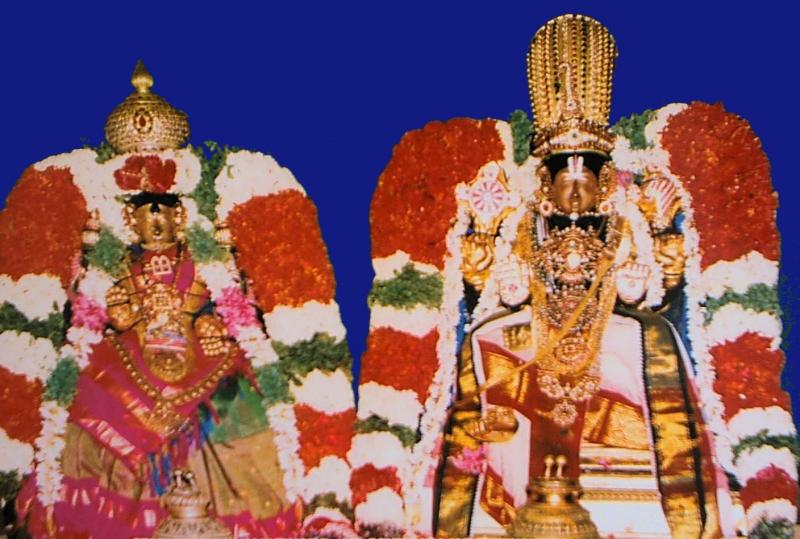GITA 10.30
 |
| THILLAINAGAR TIRUCHITHIRAKOODAM TEMPLE |
Tirumangai Alwar has sung on maximum number of Divyadesams. Starting from Tiru Piridhi, then Badarikashrama, crossing Uttar Pradesh, Andhra Pradesh, he entered Tamil Nadu, Alwar sang on Thondai region [தொண்டை நாடு] temples, and arrived at Nadu [நடு] region. There he visits Tirokkovalur [திருக் கோவலூர்] and Tiruvahindrapuram [திருவஹீந்த்ரபுரம்]. Then he entered Chola region. The first temple in Chola region was Tillainagar Tiru Chithirakoodam [தில்லை நகர் திருச் சித்திர கூடம்]. Both Kulasekhara Alwar and Tirumangai Alwar have praised the Lord here as Sri Rama and Sri Krishna. This place is popularly known as Chidambaram. Tiru indicates the association of Sri Mahalakshmi. Chitra means beautiful. Kootam denotes a place. So, this place is beautiful with Sri Thayar and the Lord is enjoying in a reclining pose. The Lord graces the devotees in standing or sitting or reclining poses. The Moolavar Sri Govindaraja is gracing in a reclining pose. There are two Utsavars. One, Sri Parthasarathy or Sri Devadideva, in a seated pose and another Sri Chithirakoodam Ullan [சித்திரக் கூடம் உள்ளான்] in standing pose. Thus all three poses are exhibited by the Lord. We are near the tall Dwajasthambam.
 |
| DWAJASTHAMBAM |
Dwajasthambam is known in Tamil as Karulakkodi [கருளக் கொடி or கருடக் கொடி]. It is the flag mast of the Lord declaring His victory. We are welcomed by the Three tier main Gopuram. On the right we have Garuda and on the left is Hanuman. Then we cross Maha mandapam and Ardha mandapam. Then we reach Garbhagruha, where the Lord is reclining.
 |
| MOOLAVAR SRI GOVINDARAJA PERUMAL |
Sage Kanva was doing a severe penance in the Himalayas. The Lord conveyed to him that He would appear to him at Pundarika Kshetram in Pundarika vanam, on the banks of Pundarika pushkarini. Sage Kanva came here and waited for the Lord. Sage Narada had a disciple sage Pundarika, who prayed the Lord to appear before him. Kshetram got the name from that sage. Pundarikam also means lotus flowers and the pond was full of lotus flowers. Sri Thayar is Sri Pundarikavalli. The Lord appeared on a Uthram star day of Panguni month. A demon king had two daughters Thilli and Villi. Once the Lord chased and drove away three demons. Of them, one demon stayed in Sri Mushnam, where the Lord is Sri Bhu Varaha. His daughters were Thilli and Villi. They prayed to the Lord at Sri Mushnam to eliminate their sins. The Lord made Villi the guard in that place. Thilli was asked to come to Pundarika vanam, where the Lord was to appear and she could serve the Lord. Thus Thilli's vanam [forest] became Thillai in due course. From Sri Vaikuntam, the Lord came to Tirumala. On His way to Srirangam, the Lord saw this place and decided to make it His abode. Thus He is called Sri Govinda Rajan.


ஸ்ரீ புண்டரீகவல்லி சமேத ஸ்ரீ கோவிந்தராஜன்
Alwar says the Lord here is none other than the Lord of Tirumala. By uttering Govinda, all our sins are erased. 'Go' means speech, cow and earth. So He maintains cows, creates the earth and guards our speech. There is a sloka by Prahlada, which says that as we get up from bed in the morning we should chant the Divine name, Govinda. It would guard the whole day and night. Prahlada was born among Asuras, who were opposed to the Lord. Similarly, among Rakshasas, Vibheeshana was a noble one.
Now sloka 30:
prahladas casmi daityanam
kalah kalayatam aham
mrganam ca mrgendro ’ham
vainateyas ca paksinam
kalah kalayatam aham
mrganam ca mrgendro ’ham
vainateyas ca paksinam
"Among the Daitya demons I am the devoted Prahlada, among subduers I am time, among beasts I am the lion, and among birds I am Garuda."
- Shravanam = listening to the stories and greatness of the Lord
- Keerthanam = singing His praise.
- Smaranam = meditating on Him.
- Padasevanam = serving at His feet.
- Archanam = performing pooja with flowers.
- Dasyam = being His servant.
- Vandanam = prostrating to the Lord.
- Sakhyam = being friendly with Him.
- Atmanivedanam = submitting our soul unto Him.
(continued)
















